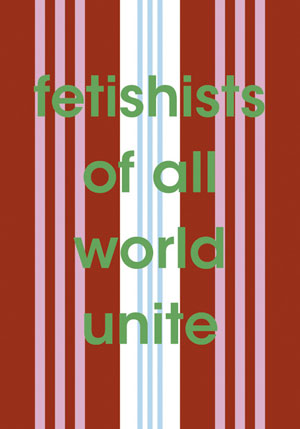|
|
| About Leonards Laganovskis’ solo exhibition Līva Raita, 3rd Year student Department of Art History Latvian Academy of Art Leonards Laganovskis. Fetishists of All World, Unite! 26.01.–27.02.2011. Rīga Art Space, Intro Hall | |
| Over an extended period Leonards Laganovskis’ work has earned the acclaim of the public and critics alike, while in his works, “strategic” ideas go hand in hand with the perfection and aestheticism of execution. This was very noticeable in the new Fetishists of All World, Unite! exhibition, for example, in the 2011 contribution to the Tribunes theme, which had begun quite a while ago. Thus Laganovskis can, for good reason, be considered as a heavyweight of Latvian art, and a full-blooded conceptualist. Serious analysis of conceptual work requires certain theoretical preparation, a wealth of experience and knowledge of the artist’s previous creative output; hence in formulating an opinion about the works on show at Laganovskis’ new exhibition, it is important to indicate the boundaries of a subjective interpretation. This must be done even more so because, firstly, Laganovskis’ works do not set these boundaries of themselves. Quite the opposite – in manipulating with signs and symbols, without directly and clearly identifying them, they operate as an open code which allows the semiotic elements to be freely decoded and interpreted. Of course, the composition of colours and the proportions of the lines in the national heraldic symbols used in the works by the artist allow one to recognize certain signs, symbols and other fetishes, but the most important thing in the semantic process is the context which develops in the mutual interaction between the works. Secondly, an awareness of the boundaries of subjective interpretation is also important because the commentary by exhibition curator Inga Šteimane didn’t serve as instruction to make the viewer see or expect something in particular in the exhibition, but expanded the possible boundaries in the interpretation of the context of the works exhibited even further. | |
 Leonards Laganovskis. From the series of 18 works 'Fetishists of All World, Unite!'. Oil on cardboard. 100x70 cm. 2010 | |
| Taking into account all of the above, I’ll leave a deeper analysis of the interrelationships in Laganovskis’ works to semioticians and conceptual art theorists, and will take the comment under a work in a 2010 competition for an airport lounge at Berlin’s Brandenburg International Airport (BBI): “Judges’ decision: forgo art at airports” as the conceptual key to the exposition. The modified “fetishes” in Laganovskis’ work encourage us to think about them as a repository of collective memory. In the context of the work and the comment, the message about the rejection of art transforms into conceptual reflections about a rejection of ethnicity, people and nations and “memory repositories” of historical events at a place overcome by feverish fear and the thoroughfare of the masses symbolic of globalization – at an airport. At the same time, by repeating, modifying and interacting the signs and symbols don’t disappear or dissipate – through association, the lines and proportions, rhythm and sense of colour project into the consciousness, becoming active and thus confirming that sign and symbol are part of those structures which, in a person’s psyche, rise to the surface and reconstruct themselves anew as soon as there is reference to correspondence with any of their elements. As is well known, the maroon-white-maroon flag was semantically present during Soviet times in the defined relationship of its dark and light proportions and its particular colour composition. The black lines and white circle on a red field work similarly in combination. In my view, the exhibition was an observation of global processes (the writing in English on the posters, done in oils, of “fetishists of all world unite” unmistakably puts a stamp of internationalism on it), in which a certain sarcasm and scepticism by the artist could be detected, and it undoubtedly is art – not some sort of problem solving, but the expression of an active position. The exhibition was definitely also an intellectual challenge, which required the viewer’s own initiative and wish whether or not to reflect any further on their newly acquired experience. It seems that the exhibition achieved its goal: it gave viewers visual information which challenged them and even placed them in an uncomfortable situation, making them feel a little like part of an ethnic group, people or nation which has lost its unique “greatness” and has been left with the strangling belt of globalization, which features in Laganovskis’ posters as the three stripes that brand everything. The interpretation of the three stripes, obviously, is dependent on the viewer’s own personal experience and geopolitical position – whether as the Adidas brand, which could easily refer to the linkage of the exhibition theme with consumer society, or hooligans’ trousers, or a road sign (less likely). On reflection the only thing that was missing for me personally, both during my visit to the exhibition and afterwards, was interactivity. What should a viewer do with their reflections on a conceptual exhibition – which therefore seems especially close to the reality of life – that do not give peace and urge one to discussion? That’s why I invite everyone who has been inspired by the exhibition towards an exchange of views to express their opinions in the comments section below my text. I believe that Laganovskis’ works, exhibited under the slogan of “Fetishists of All World, Unite!”, are definitely worthy of discussion.* /Translator into English: Uldis Brūns/ * The text can be found at the portal www.studija.lv/?parent=4269, where you are welcome to join in the discussion. [Ed. note] | |
| go back | |







